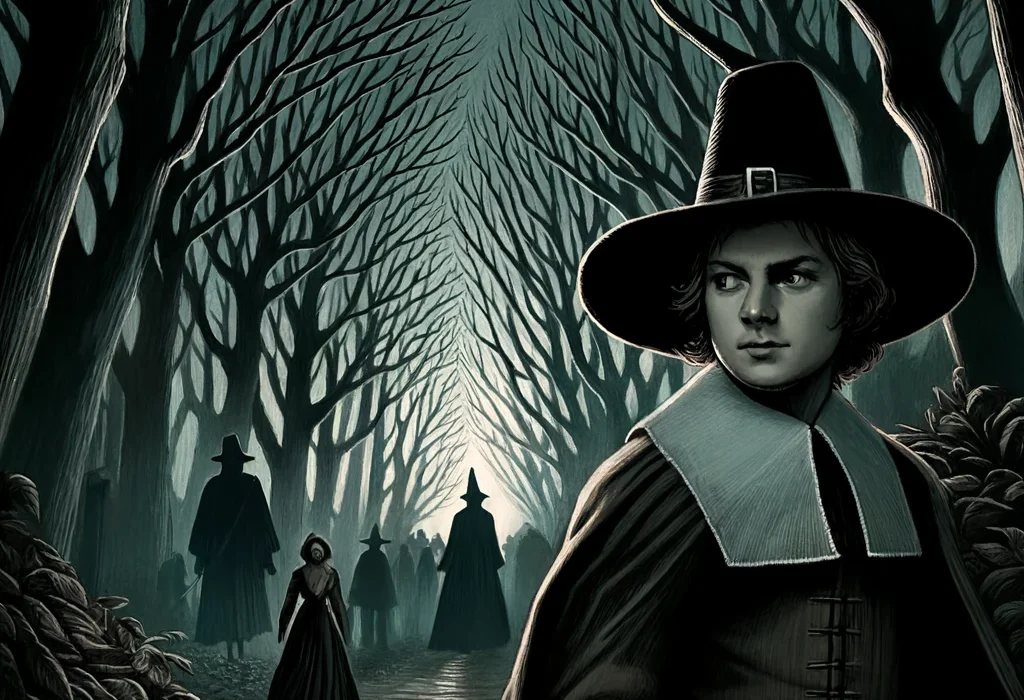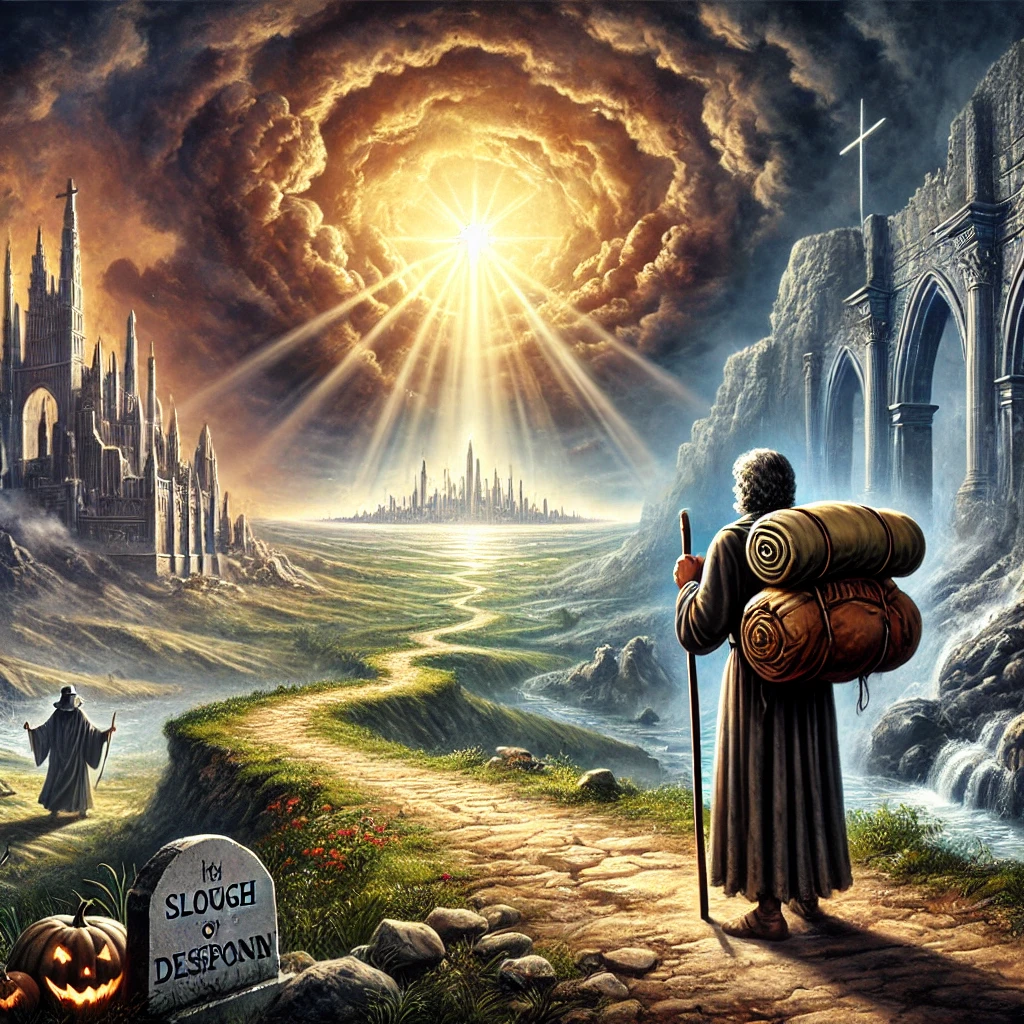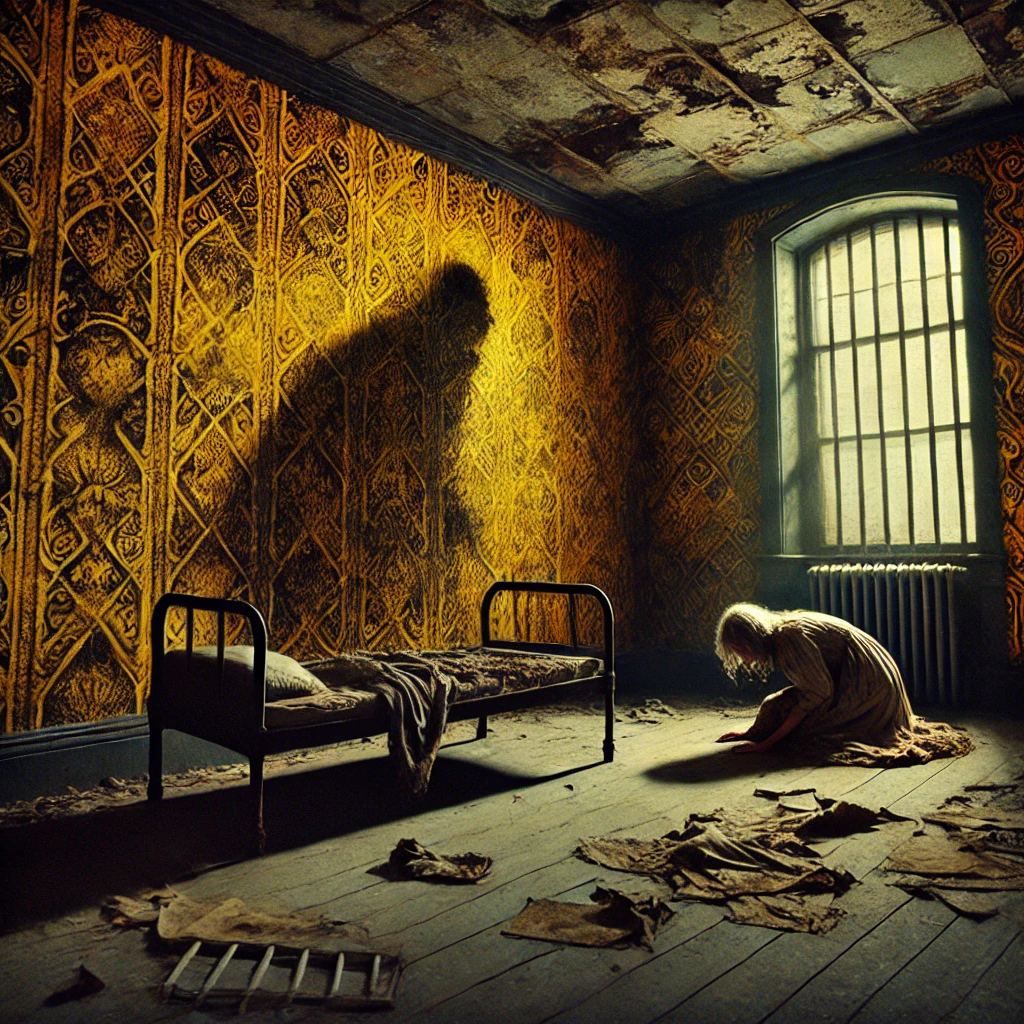“Young Goodman Brown,” written by Nathaniel Hawthorne and published in 1835, is a dark, allegorical short story set in 17th-century Puritan New England. The narrative delves into the conflict between faith and sin, exploring the psychological and moral struggles of its protagonist. This tale is a profound exploration of human nature, dealing with themes of guilt, hypocrisy, and the loss of innocence.
Plot Summary
At sunset, Goodman Brown leaves his home in Salem village, pausing only to exchange a tender farewell with his young wife, Faith. Her pink ribbons flutter in the evening breeze as she softly pleads with him to stay, confessing fears and dreams that trouble her. But Goodman Brown, determined, assures her that he must make this journey tonight, though he promises to return by morning. With that, he sets off into the darkening forest, his heart heavy with the thought of leaving Faith behind, though he resolves that after this one night, he will cling to her forever.
The road he follows is dreary and shrouded in thick trees, closing in as if to swallow him. Goodman Brown begins to feel a creeping sense of dread, knowing not who or what might lurk behind the trunks of the forest. His thoughts turn to the possibility of encountering the Devil himself. As if conjured by his thoughts, Goodman Brown soon meets a man in the woods who bears a striking resemblance to himself, though older and more worldly. This man, carrying a staff shaped like a writhing black snake, seems to have been expecting Goodman Brown.
The two walk together deeper into the forest, and the elder traveler casually reveals unsettling truths about Goodman Brown’s ancestors. He speaks of his involvement in sinful acts alongside Goodman Brown’s father and grandfather, shaking the young man’s confidence in his family’s pious history. Goodman Brown, disturbed by these revelations, declares that he intends to return to the village, but the traveler encourages him to continue, hinting that many of the good people of Salem have made this same journey. Despite his reservations, Goodman Brown finds himself moving forward.
As they continue, they encounter Goody Cloyse, a respected old woman who taught Goodman Brown his catechism. To his horror, she greets the elder traveler as a familiar companion and laments the theft of her broomstick, which she had planned to ride to a mysterious meeting that night. Goodman Brown watches in disbelief as the traveler hands her his staff, which seems to transform into a living serpent, and she disappears into the darkness. Shaken, Goodman Brown realizes that this woman he had thought so virtuous is in league with the Devil.
Determined to turn back, Goodman Brown sits down on a tree stump, resolved to return to Faith and leave behind whatever wickedness he had been about to encounter. But even as he convinces himself that he will resist temptation, the sounds of approaching horses force him to hide. He hears the voices of his minister and Deacon Gookin, discussing their eagerness to attend the night’s gathering. The voices of these two righteous men, mingling with talk of deviltry, crush Goodman Brown’s remaining illusions about the goodness of his community.
Despairing, he looks up at the night sky, hoping to find solace in the sight of heaven. But a dark cloud obscures the stars, and from within it, he hears strange, indistinct voices, as if the very souls of his fellow townspeople are speaking. One voice, in particular, stands out—a woman’s voice, filled with sorrow and entreaty. It is the voice of Faith. With a cry of desperation, Goodman Brown calls out her name, but the only response is the mocking echo of his own voice, as though the forest itself is taunting him. A pink ribbon floats down from the sky, catching on a branch.
“My Faith is gone!” Goodman Brown cries out in despair. Overcome by a sense of hopelessness, he abandons all resistance and plunges deeper into the forest. He moves at a frantic pace, no longer caring about the consequences of his actions. The forest grows wild and nightmarish around him, filled with grotesque sounds and shapes. He laughs madly, challenging the very forces of darkness to show themselves, as if he now embraces the evil he once feared.
At last, he reaches a clearing, where he sees a strange assembly gathered around a blazing rock. Flames lick at the tops of the trees, casting an eerie glow over the congregation, which consists of both the most pious and the most sinful members of the community. Goodman Brown is horrified to recognize many familiar faces—his minister, Deacon Gookin, Goody Cloyse, and even high-ranking women from the governor’s household. All stand together, unashamed, as if the divide between saint and sinner has been obliterated.
In the midst of this crowd, Goodman Brown sees a veiled figure led by Goody Cloyse and another woman known for her wickedness. His heart sinks as he realizes it is his beloved Faith, about to be initiated into this unholy communion. The dark figure presiding over the ceremony, who bears a resemblance to a grave Puritan minister, welcomes them all to the “communion of your race,” where evil is revealed to be the true nature of mankind. He promises that the newly initiated will see into the hearts of their neighbors and learn the secret sins of all they once revered.
As the figure dips his hand into a basin that might hold blood or fire, preparing to mark the converts, Goodman Brown cries out in a final, desperate plea for Faith to look up to heaven and resist. At that moment, the scene vanishes. Goodman Brown finds himself alone in the forest, the night calm once again. He staggers back to Salem village, dazed and uncertain whether the events of the night were real or a terrible dream.
The next morning, Goodman Brown returns to the village, but he is a changed man. The sight of his minister fills him with dread, and he shrinks away from Deacon Gookin’s prayers. Even the sight of Faith, who greets him joyfully, fills him with distrust and sorrow. From that day on, Goodman Brown lives a life of gloom and despair, his faith in humanity shattered. He becomes a stern, bitter man, incapable of joy or trust, forever haunted by the vision of sin he witnessed—or imagined—on that fateful night. When he dies, his grave bears no hopeful inscription, and no one speaks of his soul’s rest.
Main Characters
Goodman Brown: The protagonist, a young man who embarks on a mysterious journey into the forest that challenges his faith in his community, his religion, and ultimately, in himself. Throughout the story, he wrestles with his perception of morality and sin, and the experience leaves him a changed, bitter man.
Faith: Goodman Brown’s wife, symbolically named to represent Brown’s religious faith. She appears briefly but is central to the story, as Goodman Brown’s internal struggle revolves around his doubts about her purity and innocence, mirroring his broader loss of faith.
The Elder Traveler (Devil): A mysterious man who accompanies Goodman Brown on his journey. He represents temptation and the embodiment of evil, revealing to Goodman Brown the sinful nature of the people he once considered righteous.
Goody Cloyse: A pious old woman and a spiritual mentor to Goodman Brown, whom he discovers in league with the Devil. Her presence in the devilish ceremony shatters his belief in the goodness of the people around him.
Deacon Gookin: A respected religious leader in the town who is revealed to be participating in satanic rituals, further eroding Goodman Brown’s trust in his community.
Theme
Faith and Doubt: The story is a deep exploration of religious faith and the fragility of belief. As Goodman Brown ventures into the forest, his faith in humanity and religion is tested, leading to profound doubts that shape the rest of his life.
The Nature of Evil: Hawthorne explores the concept of inherent sin and the duality of human nature, suggesting that beneath the veneer of righteousness lies a dark, sinful core. The story portrays evil as a pervasive force that even the most pious people cannot escape.
Loss of Innocence: Goodman Brown’s journey is symbolic of a loss of innocence, as he comes to see the world and its people as inherently corrupt. This loss is a devastating blow, leaving him disillusioned and alienated.
Hypocrisy of Society: The people Goodman Brown once admired are shown to be duplicitous, participating in dark, satanic rituals while maintaining an outward appearance of piety. This theme criticizes the hypocrisy of religious and societal institutions.
Writing Style and Tone
Nathaniel Hawthorne’s writing in “Young Goodman Brown” is characterized by a richly descriptive and symbolic style, filled with dark, gothic elements. His language is ornate and often formal, capturing the Puritanical setting of the story. Hawthorne masterfully uses imagery and allegory to convey deeper moral and psychological themes, making the narrative feel both intimate and universal.
The tone of the story is one of growing dread and disillusionment. It starts with a sense of curiosity and slight foreboding, but as Goodman Brown journeys deeper into the forest, the tone becomes increasingly dark and ominous. By the end of the story, the tone shifts to one of bitter despair and cynicism, reflecting Goodman Brown’s internal transformation. Hawthorne effectively builds suspense and a sense of impending doom, using the forest and nightfall as metaphors for Goodman Brown’s descent into spiritual and emotional turmoil.
We hope this summary has sparked your interest and would appreciate you following Celsius 233 on social media:
There’s a treasure trove of other fascinating book summaries waiting for you. Check out our collection of stories that inspire, thrill, and provoke thought, just like this one by checking out the Book Shelf or the Library
Remember, while our summaries capture the essence, they can never replace the full experience of reading the book. If this summary intrigued you, consider diving into the complete story – buy the book and immerse yourself in the author’s original work.
If you want to request a book summary, click here.
When Saurabh is not working/watching football/reading books/traveling, you can reach him via Twitter/X, LinkedIn, or Threads
Restart reading!








